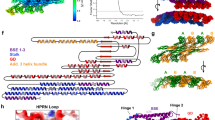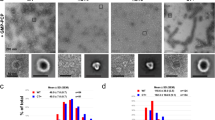Abstract
Dynamins form a superfamily of large mechano-chemical GTPases that includes the classical dynamins and dynamin-like proteins (DLPs)1. They are found throughout the Eukarya, functioning in core cellular processes such as endocytosis and organelle division1. Many bacteria are predicted by sequence to possess large GTPases with the same multidomain architecture that is found in DLPs2. Mechanistic dissection of dynamin family members has been impeded by a lack of high-resolution structural data currently restricted to the GTPase3,4 and pleckstrin homology5 domains, and the dynamin-related human guanylate-binding protein6. Here we present the crystal structure of a cyanobacterial DLP in both nucleotide-free and GDP-associated conformation. The bacterial DLP shows dynamin-like qualities, such as helical self-assembly and tubulation of a lipid bilayer. In vivo, it localizes to the membrane in a manner reminiscent of FZL7, a chloroplast-specific dynamin-related protein with which it shares sequence similarity. Our results provide structural and mechanistic insight that may be relevant across the dynamin superfamily. Concurrently, we show compelling similarity between a cyanobacterial and chloroplast DLP that, given the endosymbiotic ancestry of chloroplasts8, questions the evolutionary origins of dynamins.
This is a preview of subscription content, access via your institution
Access options
Subscribe to this journal
Receive 51 print issues and online access
$199.00 per year
only $3.90 per issue
Buy this article
- Purchase on Springer Link
- Instant access to full article PDF
Prices may be subject to local taxes which are calculated during checkout



Similar content being viewed by others
References
Praefcke, G. J. & McMahon, H. T. The dynamin superfamily: universal membrane tubulation and fission molecules? Nature Rev. Mol. Cell Biol. 5, 133–147 (2004)
van der Bliek, A. M. Functional diversity in the dynamin family. Trends Cell Biol. 9, 96–102 (1999)
Reubold, T. F. et al. Crystal structure of the GTPase domain of rat dynamin 1. Proc. Natl Acad. Sci. USA 102, 13093–13098 (2005)
Niemann, H. H., Knetsch, M. L., Scherer, A., Manstein, D. J. & Kull, F. J. Crystal structure of a dynamin GTPase domain in both nucleotide-free and GDP-bound forms. EMBO J. 20, 5813–5821 (2001)
Ferguson, K. M., Lemmon, M. A., Schlessinger, J. & Sigler, P. B. Crystal structure at 2.2 Å resolution of the pleckstrin homology domain from human dynamin. Cell 79, 199–209 (1994)
Prakash, B., Praefcke, G. J., Renault, L., Wittinghofer, A. & Herrmann, C. Structure of human guanylate-binding protein 1 representing a unique class of GTP-binding proteins. Nature 403, 567–571 (2000)
Gao, H., Sage, T. L. & Osteryoung, K. W. FZL, an FZO-like protein in plants, is a determinant of thylakoid and chloroplast morphology. Proc. Natl Acad. Sci. USA 103, 6759–6764 (2006)
McFadden, G. I. Endosymbiosis and evolution of the plant cell. Curr. Opin. Plant Biol. 2, 513–519 (1999)
Obar, R. A., Collins, C. A., Hammarback, J. A., Shpetner, H. S. & Vallee, R. B. Molecular cloning of the microtubule-associated mechanochemical enzyme dynamin reveals homology with a new family of GTP-binding proteins. Nature 347, 256–261 (1990)
Song, B. D. & Schmid, S. L. A molecular motor or a regulator? Dynamin’s in a class of its own. Biochemistry 42, 1369–1376 (2003)
Hinshaw, J. E. & Schmid, S. L. Dynamin self-assembles into rings suggesting a mechanism for coated vesicle budding. Nature 374, 190–192 (1995)
Carr, J. F. & Hinshaw, J. E. Dynamin assembles into spirals under physiological salt conditions upon the addition of GDP and γ-phosphate analogues. J. Biol. Chem. 272, 28030–28035 (1997)
Stowell, M. H., Marks, B., Wigge, P. & McMahon, H. T. Nucleotide-dependent conformational changes in dynamin: evidence for a mechanochemical molecular spring. Nature Cell Biol. 1, 27–32 (1999)
Warnock, D. E., Hinshaw, J. E. & Schmid, S. L. Dynamin self-assembly stimulates its GTPase activity. J. Biol. Chem. 271, 22310–22314 (1996)
Tuma, P. L. & Collins, C. A. Activation of dynamin GTPase is a result of positive cooperativity. J. Biol. Chem. 269, 30842–30847 (1994)
Salim, K. et al. Distinct specificity in the recognition of phosphoinositides by the pleckstrin homology domains of dynamin and Bruton’s tyrosine kinase. EMBO J. 15, 6241–6250 (1996)
Danino, D., Moon, K. H. & Hinshaw, J. E. Rapid constriction of lipid bilayers by the mechanochemical enzyme dynamin. J. Struct. Biol. 147, 259–267 (2004)
Sweitzer, S. M. & Hinshaw, J. E. Dynamin undergoes a GTP-dependent conformational change causing vesiculation. Cell 93, 1021–1029 (1998)
Narayanan, R., Leonard, M., Song, B. D., Schmid, S. L. & Ramaswami, M. An internal GAP domain negatively regulates presynaptic dynamin in vivo: a two-step model for dynamin function. J. Cell Biol. 169, 117–126 (2005)
Zhang, P. & Hinshaw, J. E. Three-dimensional reconstruction of dynamin in the constricted state. Nature Cell Biol. 3, 922–926 (2001)
Chen, Y. J., Zhang, P., Egelman, E. H. & Hinshaw, J. E. The stalk region of dynamin drives the constriction of dynamin tubes. Nature Struct. Mol. Biol. 11, 574–575 (2004)
Klockow, B. et al. The dynamin A ring complex: molecular organization and nucleotide-dependent conformational changes. EMBO J. 21, 240–250 (2002)
Ghosh, A., Praefcke, G. J., Renault, L., Wittinghofer, A. & Herrmann, C. How guanylate-binding proteins achieve assembly-stimulated processive cleavage of GTP to GMP. Nature 440, 101–104 (2006)
Hales, K. G. & Fuller, M. T. Developmentally regulated mitochondrial fusion mediated by a conserved, novel, predicted GTPase. Cell 90, 121–129 (1997)
Hermann, G. J. et al. Mitochondrial fusion in yeast requires the transmembrane GTPase Fzo1p. J. Cell Biol. 143, 359–373 (1998)
Santel, A. & Fuller, M. T. Control of mitochondrial morphology by a human mitofusin. J. Cell Sci. 114, 867–874 (2001)
Rapaport, D., Brunner, M., Neupert, W. & Westermann, B. Fzo1p is a mitochondrial outer membrane protein essential for the biogenesis of functional mitochondria in Saccharomyces cerevisiae. J. Biol. Chem. 273, 20150–20155 (1998)
Stock, D., Perisic, O. & Löwe, J. Robotic nanolitre protein crystallisation at the MRC Laboratory of Molecular Biology. Prog. Biophys. Mol. Biol. 88, 311–327 (2005)
Acknowledgements
We acknowledge support on beamlines ID29, ID14eh4 and ID23eh1 at the ESRF. We thank J. Meeks and K. Hagan for supplying bacterial strains and N. punctiforme plasmids including pSCR202; S. Reichelt for support with confocal microscopy; and J. Butler for performing the analytical ultracentrifugation experiments. We thank the MRC for a PhD student fellowship to H.H.L.
Author information
Authors and Affiliations
Corresponding author
Ethics declarations
Competing interests
Atomic coordinates produced in this study have been deposited in the Protein Data Bank under accession codes 2J69 (BDLP) and 2J68 (BDLP-GDP). Reprints and permissions information is available at www.nature.com/reprints. The authors declare no competing financial interests.
Supplementary information
Supplementary Notes
This file contains Supplementary Figure 1–3, Supplementary Methods, Supplementary Table 1 and additional references. (PDF 3158 kb)
Rights and permissions
About this article
Cite this article
Low, H., Löwe, J. A bacterial dynamin-like protein. Nature 444, 766–769 (2006). https://doi.org/10.1038/nature05312
Received:
Accepted:
Published:
Issue Date:
DOI: https://doi.org/10.1038/nature05312
This article is cited by
-
Small molecule agonist of mitochondrial fusion repairs mitochondrial dysfunction
Nature Chemical Biology (2023)
-
Molecular basis of IRGB10 oligomerization and membrane association for pathogen membrane disruption
Communications Biology (2021)
-
The merger that made us
BMC Biology (2020)
-
Formation and function of bacterial organelles
Nature Reviews Microbiology (2020)
-
The Syntrophy hypothesis for the origin of eukaryotes revisited
Nature Microbiology (2020)
Comments
By submitting a comment you agree to abide by our Terms and Community Guidelines. If you find something abusive or that does not comply with our terms or guidelines please flag it as inappropriate.



